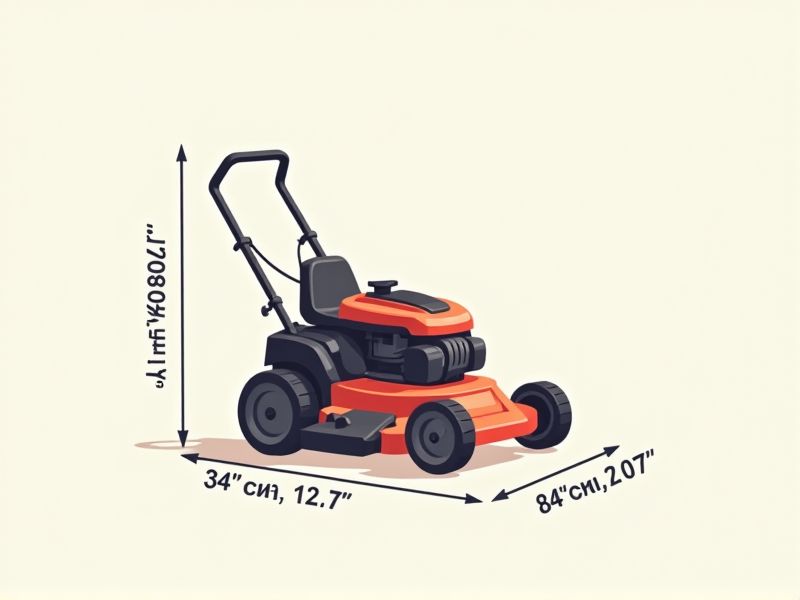
When selecting a lawn mower, it's helpful to know the standard dimensions to ensure it fits your storage space and meets your lawn size needs. Most push lawn mowers typically have a cutting width of 16 to 22 inches, with overall dimensions around 60 inches long, 25 inches wide, and 40 inches high. Riding mowers are larger, often measuring about 72 inches in length, 36 to 48 inches in width (depending on the cutting deck), and 44 inches in height. Always check the manufacturer's specifications for exact measurements, as dimensions can vary by model and brand.
Deck Size
The deck size of a lawn mower significantly influences cutting performance and efficiency, with typical dimensions ranging from 20 to 60 inches. A smaller deck, around 20-30 inches, is ideal for navigating tight spaces and small yards, while a larger deck of 42-60 inches is better suited for expansive lawns, allowing you to cover more ground quickly. Consider the terrain; for uneven or hilly landscapes, a lighter mower with a smaller deck can provide better maneuverability. When choosing your mower, assess your lawn area and specific needs to optimize your mowing experience.
Cutting Width
The cutting width of a lawn mower is a critical specification that directly influences the efficiency and speed of mowing your lawn. Most residential lawn mowers offer cutting widths between 20 to 30 inches, allowing you to cover substantial ground with fewer passes. A wider cutting width minimizes the time spent mowing, making it ideal for larger yards, while narrower models are more suitable for intricate landscapes or smaller areas. Choose a lawn mower that matches your lawn size to ensure optimal performance and minimal effort.
Wheel Size
The wheel size of a lawn mower significantly affects its performance and maneuverability, with common dimensions ranging from 7 to 12 inches. Larger wheels, typically 10 to 12 inches, offer improved handling over rough terrain and can navigate obstacles more easily, making them ideal for uneven lawns. Conversely, smaller wheels, usually around 7 to 8 inches, provide a more compact design suited for tight spaces and precise cutting on flat surfaces. Consider your lawn's topography and size when assessing the best wheel size for optimal mowing efficiency and comfort.
Handle Height
The standard handle height for lawn mowers typically ranges between 36 to 48 inches, accommodating users of varying heights for optimal comfort and control. Adjustable handles, found in many models, allow you to customize the height, ensuring a more ergonomic mowing experience. A well-placed handle not only enhances maneuverability but also reduces fatigue during prolonged use. Selecting the right handle height can significantly impact your mowing efficiency and overall satisfaction with the equipment.
Overall Length
The overall length of a lawn mower typically ranges from 50 to 70 inches, affecting maneuverability and storage. A compact model may offer an overall length as short as 36 inches, ideal for small yards and tight spaces. For professional-grade mowers, the length often exceeds 65 inches, catering to larger areas while providing stability during operation. When choosing a mower, consider how the overall length fits in your garage or storage area and facilitates your lawn care routine.
Height Adjustment Range
The height adjustment range of a standard lawn mower typically varies between 1 inch to 4 inches, allowing you to customize your grass cutting based on the species and seasonal needs. This feature is crucial for maintaining lawn health, as different grass types thrive at different heights; for example, cool-season grasses often perform best when kept at 2 to 3 inches. By utilizing the height adjustment lever or wheel settings, you can achieve an optimal cut, promoting lush growth and reducing stress on your lawn during hot months. Regularly adjusting the height ensures your mower performs efficiently and minimizes the risk of scalping, which can lead to brown patches and weakened grass.
Width For Storage
When considering a lawn mower, the width plays a crucial role in storage efficiency, typically ranging from 16 inches to 30 inches for standard models. A narrower mower, about 20 inches, can easily fit in compact spaces, like storage sheds or garages. Understanding that blade width also affects cutting efficiency ensures you achieve optimal lawn care while managing storage constraints. By choosing a mower with an appropriate width, you can enhance both your lawn maintenance experience and your available storage space.
Weight
The weight of a lawn mower significantly impacts its maneuverability and ease of use; for instance, lightweight models typically weigh between 30 to 70 pounds, making them ideal for small to medium-sized yards. Conversely, heavier mowers, ranging from 70 to 150 pounds, often provide added durability and stability, making them suitable for larger areas. You can expect that a mower's weight will also influence its storage options, as lighter models can be easily hung or stored in compact spaces. Overall, selecting a lawn mower within the 30 to 150-pound range allows for a balance between performance and convenience tailored to your lawn care needs.
Fuel Tank Capacity
A standard lawn mower typically features a fuel tank capacity ranging between 0.5 to 1.5 gallons, allowing for extended mowing sessions without frequent refueling. A larger tank not only reduces interruptions but also enhances overall efficiency, especially for larger lawns exceeding 1,000 square feet. For optimal performance, consider that gasoline mowers generally consume about 0.5 to 1 gallon of fuel per hour, depending on engine size and terrain. Ensuring your mower has an adequate fuel capacity ensures consistent power and minimizes downtime during maintenance tasks.
Blade Thickness
The optimal blade thickness for a standard lawn mower typically ranges from 0.125 to 0.25 inches, providing a balance between durability and cutting efficiency. Thicker blades, around 0.25 inches, can withstand tougher grass conditions and prevent bending or breaking during operation. However, blades that are too thick may also resist sharper edges, affecting the quality of the cut. If you're considering an upgrade, ensure your mower's motor can handle the thickness for optimal performance.
